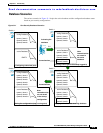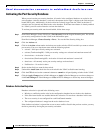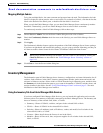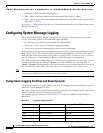
CHAPTER
Send documentation comments to mdsfeedback-doc@cisco.com.
32-1
Cisco MDS 9000 Family Fabric Manager Configuration Guide
OL-6965-03, Cisco MDS SAN-OS Release 2.x
32
Network Monitoring
The primary purpose of Fabric Manager is to manage the network. In particular, SAN discovery and
network monitoring are two of its key network management capabilities.
This chapter contains the following sections:
• SAN Discovery and Topology Mapping, page 32-1
• Configuring System Message Logging, page 32-4
• Health and Event Monitoring, page 32-10
SAN Discovery and Topology Mapping
Fabric Manager provides extensive SAN discovery, topology mapping, and information viewing
capabilities. Fabric Manager collects information on the fabric topology through SNMP queries to the
switches connected to it. Fabric Manager recreates a fabric topology, presents it to the user in a
customizable map, and provides inventory and configuration information in multiple viewing options.
Device Discovery
Once Fabric Manager is invoked, a SAN discovery process begins. Using information polled from a seed
Cisco MDS 9000 Family switch, including Name Server registrations, Fibre Channel Generic Services
(FC-GS), Fabric Shortest Path First (FSPF), and SCSI-3, Fabric Manager automatically discovers all
devices and interconnects on one or more fabrics. All available switches, host bus adapters (HBAs), and
storage devices are discovered. The Cisco MDS 9000 Family switches use Fabric-Device Management
Interface (FMDI) to retrieve HBA model, serial number and firmware version, and host operating-system
type and version discovery without host agents. Fabric Manager gathers this information through SNMP
queries to each switch. The device information discovered includes device names, software revision
levels, vendor, ISLs, PortChannels, and VSANs.
Topology Mapping
Fabric Manager is built upon a topology representation of the fabric. Fabric Manager provides an
accurate view of multiple fabrics in a single window by displaying topology maps based on device
discovery information. The user may modify the topology map icon layout with an easy-to-use,
drag-and-drop interface. The topology map visualizes device interconnections, highlights configuration


















